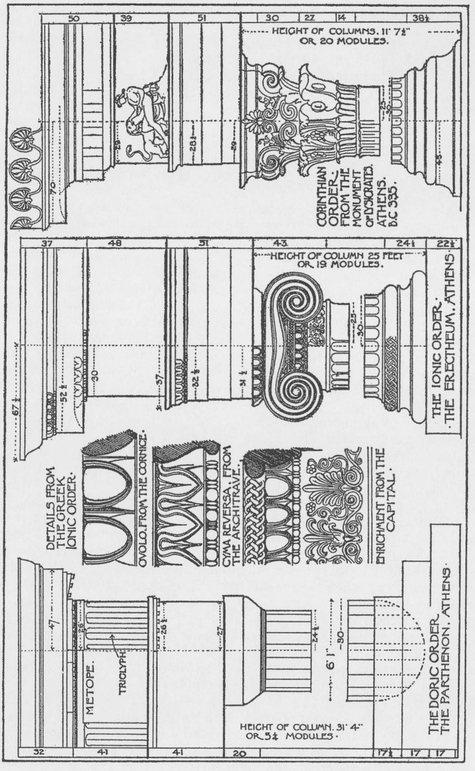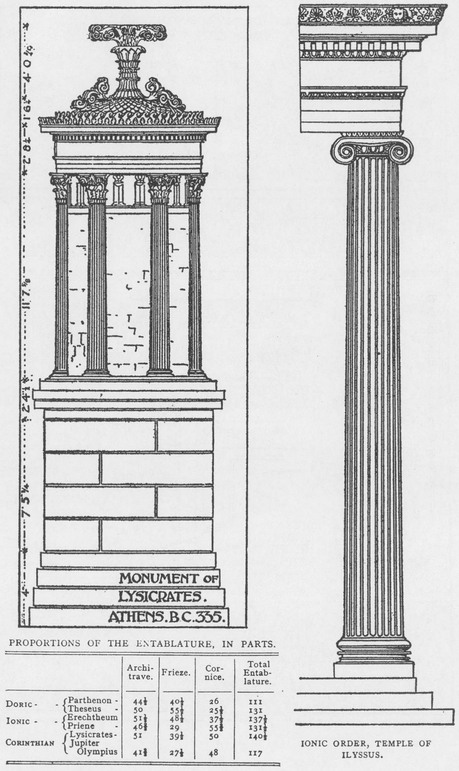Plate 6

GREEK ARCHITECTURE
Classic or columnar architecture is divided into the Greek and Roman styles, and each style comprises several orders of architecture : the Grecian orders are the Doric, the Ionic, and the Corinthian, and many examples of each of these orders are still extant in Greece and her colonies—Asia Minor, Southern Italy, and Sicily. From a comparison of these buildings, certain constructive and decorative features are observed to be present, and thence they are considered as the characteristics of the style or order, which comprises the Base (except in the Grecian Doric, which has no base), Column and Capital, and the Entablature, which consists of the Architrave, Frieze and Cornice. The proportions of these orders are generally determined by the lower diameter of the column, which is divided into 2 modules or 60 parts, the height of the column always including the base and capital. The DORIC order was used for the early Greek temples from 650 B.C., and culminated in the Parthenon, 438 B.C. The COLUMNS in this order are  to 6 diameters in height, with 20 shallow flutings with intermediate sharp arrises ; the CAPITAL is half a diameter in height, and is composed of an echinus or ovolo moulding with annulets or deep channellings below, and a large square abacus above. The ARCHITRAVE is plain ; the FRIEZE is enriched by rectangular blocks, with 3 vertical channellings in the face, termed triglyphs, alternately with square metopes which were frequently sculptured. The CORNICE, composed of simple mouldings, projects considerably beyond the face of the frieze.
to 6 diameters in height, with 20 shallow flutings with intermediate sharp arrises ; the CAPITAL is half a diameter in height, and is composed of an echinus or ovolo moulding with annulets or deep channellings below, and a large square abacus above. The ARCHITRAVE is plain ; the FRIEZE is enriched by rectangular blocks, with 3 vertical channellings in the face, termed triglyphs, alternately with square metopes which were frequently sculptured. The CORNICE, composed of simple mouldings, projects considerably beyond the face of the frieze.
The IONIC order has COLUMNS of from 9 to  diameters in height, with 24 flutings divided by narrow fillets ; the BASE is half a diameter in height, and composed of a plinth, torus, fillet, cavetto, fillet, torus, and fillet. The CAPITAL is
diameters in height, with 24 flutings divided by narrow fillets ; the BASE is half a diameter in height, and composed of a plinth, torus, fillet, cavetto, fillet, torus, and fillet. The CAPITAL is  of a diameter high, and consists of a pair of double scrolls or volutes, supported by an echinus moulding enriched with the egg and tongue, with an astragal below.
of a diameter high, and consists of a pair of double scrolls or volutes, supported by an echinus moulding enriched with the egg and tongue, with an astragal below.

CARYATIDE, ERECHTHRUM.
The ENTABLATURE is one quarter the height of the columns, the ARCHITRAVE of one or more fascias, the FRIEZE continuous and frequently enriched with sculpture in low relief ; the CORNICE has simple and compound mouldings supported by a dentil band. Caryatides were occasionally introduced into this order ; they were female figures clad in drapery having vertical folds which re-echoed the flutings of the Ionic column. These Caryatides supported the entablature in place of the columns ; a beautiful example is in the south portico of the Erechtheum at Athens.
The CORINTHIAN order was not much used by the Greeks; the examples, however, show considerable refinement and delicacy of details. The COLUMNS are 10 diameters in height, with 24 flutings ; the BASE is half a diameter high ; the CAPITAL is a little greater than a diameter in height, and is enriched with acanthus foliated leaves and spiral volutes. The ENTABSLATURE is richer and the CORNICE deeper and more elaborate than those of the other orders.
The principal Doric buildings in Greece are :—The Temples at Corinth2, 8, 650 B.C., Ægina2, 8, 550 B.C., the Parthenon2,9, and the Theseum2, 8, 438 B.C., the Temples of Jupiter at Olympia2, 8, 436 B.C., Apollo Epicurius at Bassæ2, 8, 430 B.C., Propylæa at Athens, 431 B.C. and the Minerva at Sunium, 420 B.C. Ionic buildings are :—Temples at Ilyssus1, 7, 484 B.C., Nike Apteros1, 7, 420 B.C., and the Erechtheum, ca. 420 B.C. (see plan, plate 85), North Portico7, East Portico8, at Athens. In Asia Minor there are the Temples of Samos8, Priene8, Teos8, Diana at Ephesus9, (with 36 of its columns sculptured), and of Apollo at Miletos. Corinthian buildings are :—The Monument of Lysicrates, 335 B.C., the Tower of the Winds (octagonal in plan), and Jupiter Olympius2, 8, 200 B.C.
During the 5th century B.C., the Doric order was extensively used in the Greek colonies at Sicily. At Agrigentum there are the remains of six fine Doric temples, of which the Temple of Zeus2, 450 B.C., is the largest, being 354 by 175 feet. In this Temple were found the Telemones, or Atlantes, male figures, 25 feet in height, with their arms raised probably supporting the roof. This Temple is also remarkable for its portico of seven columns, 60 feet in height, and having the peristyle walled up.
At Selinus there are five large Doric temples2, 8, and one5, 9 with columns 57 feet in height, with an entablature of 19 feet. At Segesta there is a Doric temple2, 8 with only the peristyle complete and the columns unfluted, and at Paestum, in Southern Italy, there are two Doric temples2, 8 and a basilica5 with its porticos of nine columns each.
All these buildings in Sicily and Paestum date between 500 and 430 B.C.
CLASSIFICATION OF CLASSIC TEMPLES.
ARRANGEMENT OF COLUMNS AND WALLS.
1 Apteral When the side walls have no colonnade.
2 Peripteral When there is a colonnade standing apart from the side walls.
3 Pseudo-peripteral When the colonnade is attached to the side walls.
4 Dipteral When there is a double colonnade standing out from the walls.
5 Pseudo-dipteral When the inner row of columns is attached to the side walls.
THE RELATION OF THE ENDS OF THE TEMPLE.
In Antis When the columns do not project beyond the ends of the side walls.
Prostyle When a portico stands in front of the temple.
6 Amphi-prostyle. When there is a portico at each end.
Mono-prostyle If the portico is one column in depth.
Di-prostyle If the portico is two columns in depth.
THE NUMBER OF COLUMNS IN THE PORTICO.
7 Tetrastyle If of four columns.
8 Hexastyle If of six columns.
9 Octastyle If of eight columns.
Plate 7
